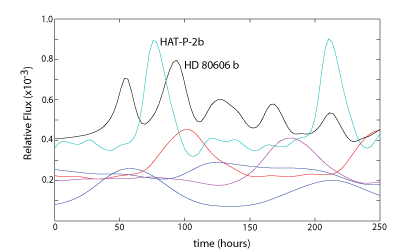
Image Source.
After several late nights of work, Jonathan Langton and I submitted our new paper that predicts the weather conditions on unevenly heated (read eccentric) short-period planets. We’re hoping that by observing these worlds in the infrared, we’ll be able to learn about the atmospheric dynamics that characterize all of the hot Jupiters.
One of our main results is a head-to-head comparison of the expected 8-micron light curves for the six most promising short-period eccentric planets. HAT-P-2b (in turquoise) comes up the winner in terms of observability, with HD 80606 b (in black) running second, and HD 118203 b (red) in third place:

In a concluding paragraph, we took the liberty to wax slightly-more-than-scientific enthusiastic about home-town favorite HD 80606b:
A short-period Jovian planet on an eccentric orbit likely presents one of the Galaxy’s most thrilling sights. One can imagine, for example, how HD 80606 b appears during the interval surrounding its hair-rising encounter with its parent star. The blast of periastron heating drives global shock waves that reverberate several times around the globe. From Earth’s line of sight, the hours and days following periastron are characterized by a gradually dimming crescent of reflected starlight, accompanied by planet-wide vortical storms that fade like swirling embers as the planet recedes from the star. It’s remarkable that we now have the ability to watch this scene (albeit at one-pixel and two-frequency resolution) from a vantage several hundred light years away.
We’ll post the paper online after it makes it through the refereeing process. And stay tuned as we get HAT-P-2b and HD 80606b ready for their multi-frequency screen tests…

Cool Greg. I look forward to reading the paper once you have posted it online.
best,
Eric